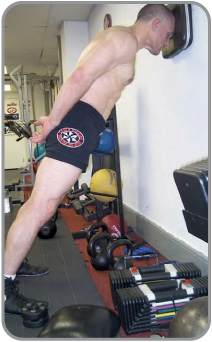
Question: Can you recommend any new exercises for a strong, muscular neck?
Not new in the real sense of the word, but sure new to the modern generation of bodybuilders. My friend and colleague Jeff Martone, RKC Sr. has brought it to my attention that old time physical culturalists had a unique way of performing the back bridge. I quote Sig Klein from his 1940s Super Physique Body-Building Bar-Bell Course:
“Lie flat on your back with barbell a few inches from your head. Grasp the bell with the hands shoulder width apart, being sure it is balanced properly. Then pull it over face to the chest and press bell up to arms length. Bring the knees up so that the feet are flat on the floor and close to the buttocks, raise your hips so that only the upper back, neck, and feet are on the floor. From this position push your body up until the upper back rises from the floor and all the weight is supported on the soles of the feet and the top of the head. From this position lower slowly until your back just about touches the floor, then rise again and repeat. Keep the barbell in upright position throughout the exercise. Inhale rising, exhale lowering.” It goes without saying that you need a reasonably soft surface such as a wrestling mat.
Note that you are not getting as much range of motion as you would from the traditional wrestler’s back bridge – which can be good or bad depending on your goals and neck health – but your neck extensors have to work very hard because of the poor leverage.
Unless you have been training your neck hard, you probably should perform the drill without any weight. Or hold a very light weight on your stomach or your chest. Also, don’t ‘jam’ your neck in one spot; imagine that you are elongating it and ‘wrapping it around’ something.
Don’t forget to work the front of your neck for a balanced development. Lower yourself into the bottom pushup position, rest your forehead on a padded surface, tense up your neck and stomach, and slowly take some weight off your hands. Breathe shallow, stay tight, and hold the position for a period of time.

The neck plank demoed by Steve Maxwell, RKC Sr.
Photos courtesy SteveMaxwell.com
The neck plank and its variations demoed by Steve Maxwell, RKC Sr.
Photos courtesy SteveMaxwell.com
Keep unloading your hands as you get stronger, until your fingertips float above the ground just to spot you. Also bring your feet in until they are together. This will also challenge your abs. Lifting one leg up is even harder but you have to be extra careful.
Once you adapt, give more work to the muscles on the sides of your neck. In the above position, but with your hands solidly planted, slowly roll your head to one side and then the other. Flaring your neck, as if you are trying to maximize its size when being measured, will help you in this and many other neck drills.
As with most neck exercises, clear these with your doctor.
Question: I read that weightlifting and strongman legend Paul Anderson had the thickest neck in the history of the iron game. How did he build it?
The late strongman listed his favorite neck routine in his book Power by Paul (highly recommended reading, available from crainsmuscleworld.com). He would superset two exercises. The first one was the conventional neck extension with a head strap. Attach a conservative poundage to such a rig, place your hands on your thighs, and lean forward. Tilt your head back while looking up, then let it come down without overstretching the back of your neck. In his first set Anderson did 50 reps!
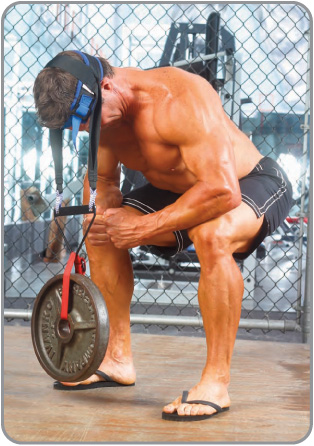
In his first set Anderson did 50 reps!
My harness of choice is made by IronMind.com.
The second drill was anything but conventional. Paul would pad a table, lean forward and rest his forehead and his hands on it. Then he would roll his neck side to side, from ear to ear, until he could not do it any longer. I do the same drill lying face down on the floor and like it even better.
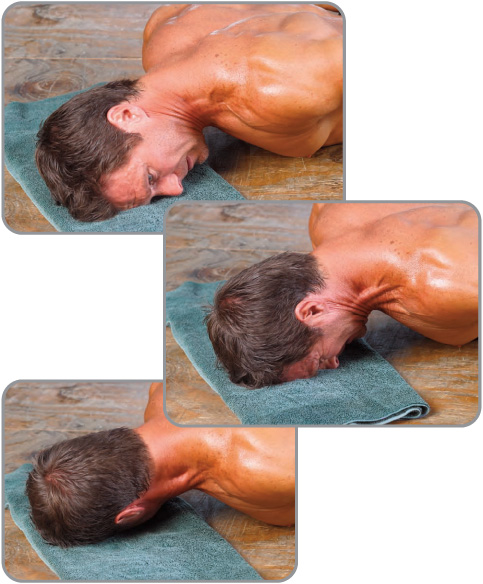
The Anderson neck roll.
After just a few seconds of rest ‘the Wonder of Nature’ repeated the superset. For the third set he increased the poundage on the harness so he was limited to 10 repetitions and wrapped up with another set of neck rolls for ‘as long as he could endure’. Very powerful, efficient, and out of the box. Very Paul Anderson.
On a side note, if you are strong enough, you may want to try the floor neck roll in the low pushup position. Very challenging; make sure to spot yourself carefully with your hands and keep constant tension in your neck.
Question: I have made great gains on the twenty-rep squat routine from Dr. Randall Strossen’s book ‘Super Squats’. Now how can I specialize on my shoulders without abandoning this squat routine?
I saw a question almost identical to yours in a 1947 issue of Peary Rader’s Ironman and I could not answer it better than old-timer Charles A. Smith did. He suggested sticking to Monday-Wednesday-Friday squatting and clean-and-pressing EVERY DAY. “Most lifters use the THREE WORK OUTS a week system, some get in four workouts or five a week, but you will have no fear of staleness or of working too hard even if you press seven days a week seven times a day,” stated Smith. “There is only ONE secret of success in pressing – and that is to press and press and press on each and every occasion you get near a bar. The record holders in the press actually use this method when they are in training to better their records.”
Now before you holler ‘Overtraining!’ you must understand what type of press training was done in the good ole’ days. The same author wrote an excellent article on power pressing two years later. “It has been said that only one man in 150,000 can press bodyweight,” wrote Smith. “As we see it, there is no earthly reason why any man of a year’s experience in weight training cannot perform this feat. The reason why the records in the press have reached such astonishing heights… is because of this intensive application of specialized training in the press. [Russian champion] Novak presses every day, likewise [American champion] Davis…” Isn’t interesting that with all the ‘modern advances’ today you will have an easier time finding a bodybuilder who does not lie about his arm size than one who can clean and press his bodyweight?
George Walsh, a British physical culture authority from those days of better men, told the story of a young man who pushed his C&P up from 160 to 200 pounds in a year. 200 pounds may not sound like a lot if you have never pressed heavy overhead but let me put this in perspective for you. A 350-pound bencher friend of mine – and we are talking about a strict, paused, no assistance equipment BP – barely cleaned and pressed 155 pounds!
The young Englishman started by military pressing 115 pounds three times a day, each time in five sets of three. That is forty-five daily reps! Every day he added a tiny washer to the bar; the jumps were so small that they totaled barely a pound a week. Get mini-plates or just improvise them out of metal wire or something similar.
This classic method that flies in the face of all the modern day pseudoscience will do wonders for your delts, provided you do no other presses, shoulder, pec, and triceps work, keep your reps super low, and stay away from muscle failure. “… while high numbers of reps are successful with a few unusual men, the majority find that a more conservative number of repetitions are best.” Walsh mentions another physical culturalist who totally failed on a similar system of training by doing too many reps per set, seven specifically (Isn’t it funny that these days seven reps qualify as ‘low’?). And “when he dropped to three reps per set, he was eminently successful.” Some things never change.
Question: I am on the road a lot and I often end up working out in hotel gyms that only have light dumbbells and machines. Lateral raises hurt my shoulders; are there any compound shoulder exercises I can do under the circumstances?
Do the Sots press named after Victor Sots, an early 1980s world champion weightlifter from Russia. It is a hit at our kettlebell instructor certification courses. Senior RKC Jeff O’Connor can Sots press a pair of 106-pound kettlebells. What a killer blend of strength and flexibility!
Take a very light dumbbell or kettlebell – if you can military press an 88-pound kettlebell for reps you might or might not get a single with a 53-pounder in the Sots press! – clean it, and squat rock bottom. Make sure your heels stay planted. Press!
Why is it so hard? Because there is no way you can cheat. And because, in addition to the weight of the bell, you are dealing with the resistance of your tight antagonist muscles. You could say that you are driving with your parking brake on. Remove the brakes with strength-flexibility drills such as the Sots press and you will have an easier time pressing weights in conventional strength exercises. You will also put on new muscle. You cannot help noticing an intense and unusual contraction of the upper back and the triceps as you are suffering through the humbling and awkward Sots press. Variety is the spice of bodybuilding life; because the nature of the strength-flexibility overload is so different from that of your usual boring exercises you are guaranteed new growth.
A few tips. Work in multiple sets of one to two reps as your strength-flexibility quickly drops off. Do not get frustrated; the Sots press is what the doctor ordered for every tight bodybuilder, even if he has all the weight he needs for conventional military presses. Practice this drill for a few months – and your shoulders will be as square as those of the Red Army show-off troops on the October Revolution anniversary parade!
Question: I am sick of having puny shoulders! I will do anything to fill them out ASAP!
Repetition dumbbell or kettlebell cleans and presses will send you shopping for new clothes in a hurry. Since studly John Allstadt, RKC started hitting kettlebell C&Ps, he quickly gained twelve pounds of muscle even though he was not even trying to gain weight.
This exercise is so powerful that Ethan Reeve, RKC the head strength and conditioning coach at Wake Forest University, believes that repping out C&Ps with a pair of seventy pound kettlebells makes a much better strength test for football players than bench pressing 225 for reps.
Brooks Kubik, the author of Dinosaur Training, is also a fan of the repetition dumbbell clean and press. His website quotes famous pre-World War II strongman and bodybuilder Sig Klein who urged aiming high for cleaning and pressing a pair of seventy-five pound dumbbells a dozen times. According to Klein very few men could complete that feat. I am sure that in these days of bench and seated presses and glass backs that number has dropped even lower.
Clean the bells from a hang or a swing before each press. This is what makes this drill so productive. Cleaning before each press adds work to the delts, hits the shoulders and the upper back from a different angle, and also helps you to get tight before the next rep.
The business of ‘getting tight’ is very important. If you do more than a couple of repetitions from your shoulders your waist and the rest of your power base will lose its tightness. This results in mediocre presses and back injuries. When you reclean the bells before each press, you are forced to brace your body to accept the shock. It is like loading a spring before the press. Make sure to press without any delay or you will lose some tightness.
Henry Duval, an old-timer friend of mine, saw the famous weightlifter David Ashman practice his jerks with 500 pounds. He could not clean that weight by himself. Instead of simply taking the barbell from the stands set up at his chest level Ashman had two guys, one on each end of the bar, help him clean the weight in a precisely synchronized and dangerous effort. Ashman understood that he could never get tight enough under a dead weight sitting in the rack. If he was willing to go to all the trouble with a huge poundage, believe it that cleaning your bells before pressing them is worth it.
Start your dumbbell or kettlebell C&Ps with a conservative poundage for a quick paced 5x5. Build up to ten sets of five over a period of a few weeks and grow like a weed.
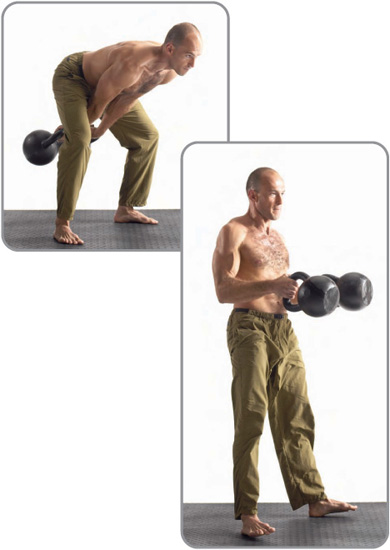
A classic: the kettlebell C&P.
The business of ‘getting tight’ is very important. If you do more than a couple of repetitions from your shoulders your waist and the rest of your power base will lose its tightness.
Question: Because of an old shoulder injury my arm locks out slightly to the side rather than straight up when I press overhead. This severely limits my dumbbell press poundages. Any ideas?
Try the alternate kettlebell or dumbbell press, but with a ‘twist’. Imagine that there is an invisible connection between the bells, as if they are parked on the opposite ends of a teeter-totter. Say you have locked out the left bell overhead and your right is still at the shoulder. Now start actively ‘pulling’ the left dumbbell down. Visualize that it is pushing down on the teeter-totter and makes the opposite bell go up.
As the bell is coming up push your hips under it. Eventually your hips should move side to side in rhythm with your presses. You will discover that turning your feet out about forty-five degrees and spreading them wider than your shoulders will help. So will keeping your quads flexed and your knees locked.
I promise that you will love the seesaw press. It is very shoulder friendly and there is an awesome powerful feeling to it. Thanks to an obscure neurological phenomenon, you will be able to handle more weight for more reps than would be possible if you pressed the bells together or separately but out of sync. Another benefit is a solid oblique workout. Even your lats will get in on the action if you do it right. Enjoy!
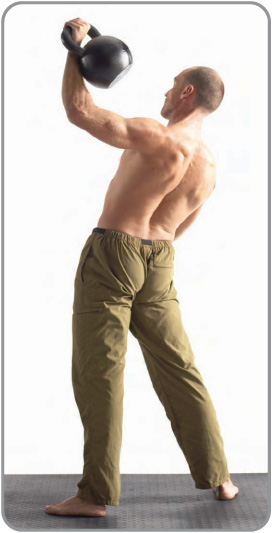
The kettlebell see-saw press: hard on the muscles, easy on the joints.
You will love the see-saw press. It is very shoulder friendly and there is an awesome powerful feeling to it.
Question: Do I need direct trap and neck work?
It depends. Powerlifters generally have very developed necks and traps just from deadlifts. Heavy explosive barbell shrugs as practiced by Olympic weightlifters quickly pack a lot of meat on both the neck and the traps. Just look at the photos of Russian weightlifting legend David Rigert.
If you wish to max out your neck size, add neck harness work to the above. Ironmind.com sells the best rig on the market. Certain sports demand highly specialized neck exercises that must be learned from professionals in your chosen sport. To give you an idea of sport specific neck training, here is an old school boxing drill I learned from boxing coach Steve Baccari, RKC.
“Lie on your stomach; place your hands under your jaw.” Steve showed me how he makes a fist with one hand and sets it down on the ground, thumb up. Then he wraps the fist with his other hand. What you get is a comfortable cup to fit your jaw in. “Have a training partner place his hands on the top of your head and slowly apply pressure. Slowly open and close your mouth. This will strengthen your jaw muscles and help prevent your lower jaw from slamming into the base of your skull. Which is what happens when you get hit on the button, as they say in the sport.”
Baccari demonstrates this drill on the Power Behind the Punch DVD available from dragondoor.com.
Question: Some bodybuilding coaches recommend foregoing deltoid exercises altogether. They argue that between benching and heavy back exercises your shoulders are covered. Is it true?
You have described a valid training approach. Indeed, heavy bench presses, pullups, cleans, etc. cannot help hitting your shoulders hard. They will grow. All you need to do is take a look at powerlifters.
If you decide to go this route, make sure that your back receives at least as much attention as your bench. And, if you forego the overhead lifts, you will have to spend plenty of time working on your shoulder girdle’s flexibility. Iron rats who make the BP the cornerstone of their routine are notorious for not being able to scratch their backs without rubbing against the doorway – and having terrible postures. “Dude, are you sure you did not forget to take off your bench shirt?”
By the way, ‘flexibility’ does not mean lowering your dumbbells deeper during your dumbbell BPs; that just wrecks your shoulders. In this context ‘flexibility’ is the ability to raise your locked arms overhead slightly behind your ears and close to the head – and a few other angles that kettlebell lifters and Olympic weightlifters are good at and bodybuilders and powerlifters suck at.
Question: Between my chest work and my delt routine I tend to easily overtrain my shoulders. Should I do fewer sets?
Cutting the weekly volume might solve your problem but you need to see the big picture. Chances are, you are doing way too many sets and reps of junky, non-productive exercises: the pec deck, bench dips, etc. Cut those out and focus on the basics: various presses with free weights. Keep your reps low, four to six, and do not push to failure. If you insist, leave one isolation type exercise per body part in your routine, a strategy employed by many successful bodybuilders.
Always training on the nerve and never backing off, a typical bodybuilding sin, is another common destroyer of shoulders. I have said it many times: cycle! That simply means starting with a light weight and building it up over a period of weeks. Do not rep out with a light poundage in the beginning of the cycle; it is supposed to be easy.
Learn to ‘keep your shoulders in their sockets’. Letting your shoulders shrug up or move forward during chest and delt exercises is very rough on the rotator cuffs. Visualizing that you are ‘pushing yourself away from the weight’ rather than pushing the weight up is an effective imagery for keeping your shoulders down.
Question: My neck gets tight after I do lateral raises and I get a headache. Should I use a lighter weight?
I am sick and tired of seeing every type of exercise discomfort being ‘solved’ by lightening the load. It is the path of least resistance – literally. Learn to perform your exercises properly!
When it comes to laterals, your problem is raising the bells too high and shrugging your shoulders. The dumbbells have no business going up higher than your shoulders in this drill. So keep your lats tight to keep your shoulder girdle down.
Also, use this effective imagery from martial arts. Instead of focusing on getting the weights up, visualize reaching out with your arms to the opposite walls. Basically, project your energy outward rather than upward. Not only will your neck give you a break, you are going to overload your delts more effectively and you are likely to be able to lift heavier bells.
A word on breathing. In this exercise you are better off inhaling steadily through your nose on the way up and exhaling on the way down.
FYI, the above tips apply just as much to bent over laterals. It goes without saying, keep your elbows locked.
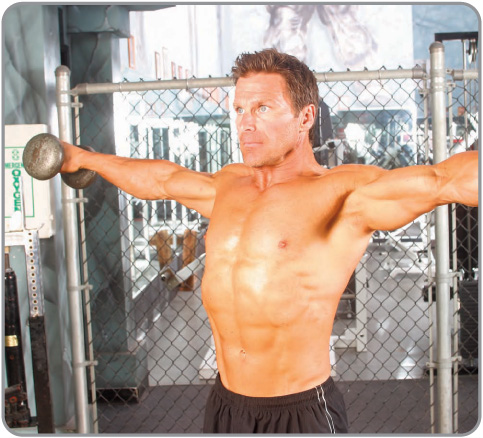
Project your energy outward!
How to jack up your neck and shoulders while failing to develop your delts.
Question: I used to get great results from presses behind the neck but my neck and shoulders cannot take PBNs any more. Are there any safer alternatives to my favorite deltoid movement?
One option is to switch to military presses from the chest but make a point of leaning against the bar as it is passing your eyes and locking out in the PBN top position.
Another is to keep on pressing behind the neck but work one shoulder at a time. The one arm PBN does not require an Olympic weightlifter’s flexibility.
Stick to the long Olympic bar; it is less likely, than a thick dumbbell, to wrench your shoulder back. Start the press with your elbow tucked into your side, as far back as comfortable. Keep the bar as much in line with your shoulders as your flexibility allows it. As the bar is passing your head, lean forward slightly to get a tight contraction of your posterior delts and the upper back muscles.
The one-arm PBN.
Question: Is it a good idea to add rotator cuff work to my routine?
If you have an injury and your doctor tells you to – definitely. Otherwise, I do not see the point. Well-balanced training – not your usual mix of benches and curls – should take care of your cuffs. York Barbell Club legend Bill Starr recalls that in the days when iron rats did fewer benches and more heavy overhead work no one even heard of rotator cuff problems. In the Russian military, where pushups are not a part of the PT test and kettlebell snatches are, shoulder problems are almost non-existent.
Do a variety of overhead lifts, especially those demanding good flexibility and loading in planes unusual for a bodybuilder: side presses, military presses with a forward lean as the bar passes your head (the lockout looks identical to that of the press behind the neck), overhead squats, Turkish get-ups, etc. Also review your bench press technique. Stay healthy!
Question: My back hurts when I do standing barbell military presses. Should I switch to seated presses?
Forget it! Do not even think that switching to seated presses will solve your problem. Compare your spine and your legs to two springs in a series. If you remove one spring, the legs, the other, or the back, will get double the compression.
Russian scientist Robert Roman, recognized in the weightlifting community as the world’s foremost expert on lifting technique, explained why some athletes have a problem with back bending during clean and presses. He said that when the waist muscles and the glutes are relaxed the athlete ends up literally pushing his torso away from the heavy weight, especially if he has a flexible spine. According to Roman, the solution is to keep the glutes and the midsection tight. Imagine that someone is about to punch you in the gut – that can be arranged! – and brace your stomach against the punch. At the same time clench your butt cheeks hard and tuck your butt under. The muscle action is identical to that in the Janda situp.
Another one of Roman’s suggestions is to bring your feet closer together. This will further reduce the back bend. Consider going to the extreme and clicking your heels together as old timers used to do. Didn’t you know that it was standing at ‘At-ten-tion!’ that gave the military press its name?
If you opt for the heels together style of military pressing squeeze your thighs together by flexing the adductors. Thanks to an obscure neurological phenomenon, this will amplify the tension in your abdominals. Your stability and power will go up even more.